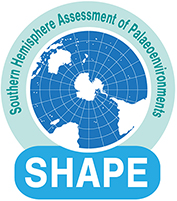SHAPE:Southern Hemisphere Assessment of Palaeo-Environments
International Focus Group (IFG) for the 2015-2019 inter-congress period
Rationale
The Southern Hemisphere (SH) contains critical elements of the global climate system. The role of the SH in determining how Earth’s climate responds to, or initiates, global changes and the fate of the SH in light of current anthropogenic climate change are open-ended discussion points. Examination of climate oscillations over glacial-interglacial periods has coarsely outlined changes related to insolation forcing and climate system feedbacks through the Quaternary, but a more detailed perspective from the SH is required for a meaningful global synthesis.Despite the limited extent of terrestrial landmasses in the SH (with respect to the land-dominated Northern Hemisphere (NH)), an increasing wealth of diverse information is being recovered from the hemisphere’s continental sectors and vast oceans. From a range of archives, we observe distinct intra- and inter-hemispheric characteristics in terms of timing and magnitude of past environmental and climate changes through the Quaternary. Despite increasing data and detail, the question remains: At both regional and hemispheric scales, how have SH climates evolved through glacial-interglacial cycles as a response to changes in the Earth system?Addressing this major question requires the integration of data from different regions of the SH into a unified view of past change using multiple proxies and climate modeling. The INQUA inter-congress International Focus Group (IFG) called the Southern Hemisphere Assessment of Palaeo-Environments (SHAPE) is working towards this unification, creating networks between Southern Hemisphere Quaternarists, fostering the development of several PALCOM projects, and promoting research to investigate past environmental characteristics and variability for the SH through the integration of proxy data and model simulations.The projects aligned to SHAPE are working to reconstruct past environments and atmospheric and oceanic circulation patterns through glacial-interglacial cycles by synthesising proxy records at both regional and hemispheric scales. These syntheses are then compared and combined with climate model simulations to arrive at a more comprehensive understanding of SH climate dynamics and their role in the global climate system. Spatially-distributed suites of terrestrial climate reconstructions reveal characteristics of the global circulation that cannot be resolved at the individual site level alone. Multiple transects from the tropics to the mid- and high-latitudes, including detailed reconstructions of currents, fronts, gyres and oceanic cross-sections, are contributing to a fuller, holistic understanding the structure of past SH circulation. By integrating regional reconstructions of atmospheric and oceanic circulation, we are able to identify key SH climate modes and understand the regional observations from a hemispheric perspective. Using climate model simulations is helping to formulate new hypotheses about triggers of climate change, climate dynamics, and mechanisms of intra- and inter-hemispheric climate teleconnections.Activities
SHAPE is supporting international research collaborations aimed at investigating past environmental variability and change for Southern Hemisphere terrestrial, ocean and cryosphere regions using and integrating proxy data with model simulations. SHAPE is fostering the development of PALCOM projects that aim to incorporate one or more of the following:
1. establishment of reliable chronologies for SH proxy records
2. development of novel records and robust proxy interpretations (qualitative and quantitative)3. generation of regionally-differentiated composites of past environmental and climatic change (temporal-geographic syntheses)4. integration of data and model simulations into hemispheric-scale syntheses, highlighting the changes and testing hypotheses for their causesSHAPE collaborations and projects are encouraged to target specific questions that will improve understanding of:• SH climate systems and connections as determined by oceanic and atmospheric circulation• environmental extremes (including opposite mean states of full glacial and interglacial conditions)• variability, transitions, tipping points and abrupt changesAn overarching SHAPE remit is to determine how drivers of circulation operated during the Quaternary. Salient details for critical intervals or climate states will emerge from SHAPE projects that are directed at the foci listed above, and will include new information on:• SH circulation structure and modes.• associated patterns of terrestrial environmental change leading into and coming out of periods of change.• timing of major changes (and whether they are regionally, hemispherically and/or globally synchronous).• identification of triggers of change via lead-lag relationships.• linking low-frequency change to high-frequency variability seen in some archives (glacial advances and retreats, hydroclimatic state in speleothems, ice cores, pollen/ecological changes, tree rings/corals, etc.).• archetypal patterns associated with climate phenomena (i.e. El Nino Southern Oscillation, Southern Annular Mode, Interdecadal Pacific Oscillation, Indian Ocean Dipole, Madden-Julian Oscillation, Pacific South American mode, Monsoon, etc) and changing patterns of teleconnections within the climate system over time.• external drivers of climatic change during the Quaternary, including orbital changes, volcanic eruptions and changes in solar irradiance.SHAPE Projects
To date, SHAPE has promoted three projects:• Palaeolakes of the Arid Southern Hemisphere (PotASH)• Last Glacial Maximum in the Southern Hemisphere (SHeMax)• Evolution of the Southern Hemisphere Westerly Winds (SWEEP)• Low latitude SH climate and the PALEO-SPCZ focused at suborbital time scales.The broad scope of SHAPE has allowed the development of a range of research themes, including:• Synoptic-scale integration of model simulations and proxy data for the SH.• Drivers and dynamics of climate change during the Onset and Terminations of major glacial episodes.• Holocene climate dynamics: variability, transitions, tipping points, and abrupt change• Defining spatial heterogeneity of SH climate to explore influences of multiple climate drivers.• Interglacial mean climate and environmental conditions, variability and change.• Changes in SH climate gradients (e.g. precipitation, ecotones) and relative roles and proportionalities of circulation, greenhouse gases and insolation on forcing glaciation.• The propagation and impact of high northern latitude events on SH climate and environmental systems.• Teleconnection pattern changes for climate drivers through time, and consequences for the interpretation of proxy data and assumptions of stationarity and uniformitarianism.As the IFG evolves, existing projects may be phased out, or become recognized projects, as they achieve their goals, allowing for new projects to submit proposals for support of their activities.For further information about SHAPE, and how to participate please email: Brian Chase (Africa); Andrew Lorrey or Steven Phipps (Australasia, Oceania, Antarctica); or Maisa Rojas (South America)


